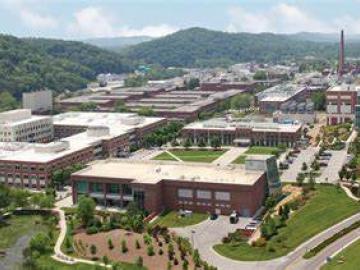Filter News
Area of Research
- Advanced Manufacturing (22)
- Biology and Environment (36)
- Building Technologies (2)
- Clean Energy (116)
- Climate and Environmental Systems (1)
- Computational Biology (1)
- Computational Engineering (3)
- Computer Science (16)
- Electricity and Smart Grid (1)
- Energy Frontier Research Centers (1)
- Functional Materials for Energy (1)
- Fusion and Fission (8)
- Fusion Energy (4)
- Isotope Development and Production (1)
- Isotopes (2)
- Materials (120)
- Materials Characterization (1)
- Materials for Computing (21)
- Materials Under Extremes (1)
- Mathematics (1)
- National Security (22)
- Neutron Science (37)
- Nuclear Science and Technology (8)
- Quantum information Science (7)
- Supercomputing (106)
- Transportation Systems (1)
News Topics
- (-) 3-D Printing/Advanced Manufacturing (115)
- (-) Computer Science (179)
- (-) Materials Science (129)
- (-) Nanotechnology (60)
- Advanced Reactors (32)
- Artificial Intelligence (81)
- Big Data (48)
- Bioenergy (86)
- Biology (93)
- Biomedical (56)
- Biotechnology (20)
- Buildings (52)
- Chemical Sciences (55)
- Clean Water (28)
- Climate Change (90)
- Composites (25)
- Coronavirus (46)
- Critical Materials (23)
- Cybersecurity (35)
- Decarbonization (68)
- Education (3)
- Element Discovery (1)
- Emergency (1)
- Energy Storage (106)
- Environment (187)
- Exascale Computing (33)
- Fossil Energy (4)
- Frontier (37)
- Fusion (51)
- Grid (58)
- High-Performance Computing (78)
- Hydropower (11)
- Irradiation (3)
- Isotopes (46)
- ITER (7)
- Machine Learning (42)
- Materials (137)
- Mathematics (6)
- Mercury (12)
- Microelectronics (2)
- Microscopy (50)
- Molten Salt (8)
- National Security (54)
- Net Zero (10)
- Neutron Science (126)
- Nuclear Energy (100)
- Partnerships (37)
- Physics (58)
- Polymers (31)
- Quantum Computing (27)
- Quantum Science (63)
- Renewable Energy (2)
- Security (23)
- Simulation (38)
- Software (1)
- Space Exploration (24)
- Statistics (2)
- Summit (56)
- Sustainable Energy (114)
- Transformational Challenge Reactor (7)
- Transportation (91)
Media Contacts

Rishi Pillai and his research team from ORNL will receive a Best Paper award from the American Society of Mechanical Engineers International Gas Turbine Institute in June at the Turbo Expo 2024 in London.

Rigoberto “Gobet” Advincula, a scientist with joint appointments at ORNL and the University of Tennessee, has been named a Fellow of the American Institute for Medical and Biological Engineering.

Held in Cocoa Beach, Florida from March 11 to 14, researchers across the computing and data spectra participated in sessions developed by staff members from the Department of Energy’s Oak Ridge National Laboratory, or ORNL, Sandia National Laboratories and the Swiss National Supercomputing Centre.

The Society of Manufacturing Engineers has honored three Oak Ridge National Laboratory researchers with the 2024 SME Susan Smyth Outstanding Young Manufacturing Engineer Award.

ORNL’s Erin Webb is co-leading a new Circular Bioeconomy Systems Convergent Research Initiative focused on advancing production and use of renewable carbon from Tennessee to meet societal needs.

Forrest Hoffman, a distinguished scientist at the Department of Energy’s Oak Ridge National Laboratory, has been named a senior member of the Institute of Electrical and Electronics Engineers, the world’s largest organization for technical professionals.

Scientists at ORNL have developed 3D-printed collimator techniques that can be used to custom design collimators that better filter out noise during different types of neutron scattering experiments
ORNL scientists have determined how to avoid costly and potentially irreparable damage to large metallic parts fabricated through additive manufacturing, also known as 3D printing, that is caused by residual stress in the material.

Canan Karakaya, a R&D Staff member in the Chemical Process Scale-Up group at ORNL, was inspired to become a chemical engineer after she experienced a magical transformation that turned ammonia gas into ammonium nitrate, turning a liquid into white flakes gently floating through the air.

SkyNano, an Innovation Crossroads alumnus, held a ribbon-cutting for their new facility. SkyNano exemplifies using DOE resources to build a successful clean energy company, making valuable carbon nanotubes from waste CO2.




